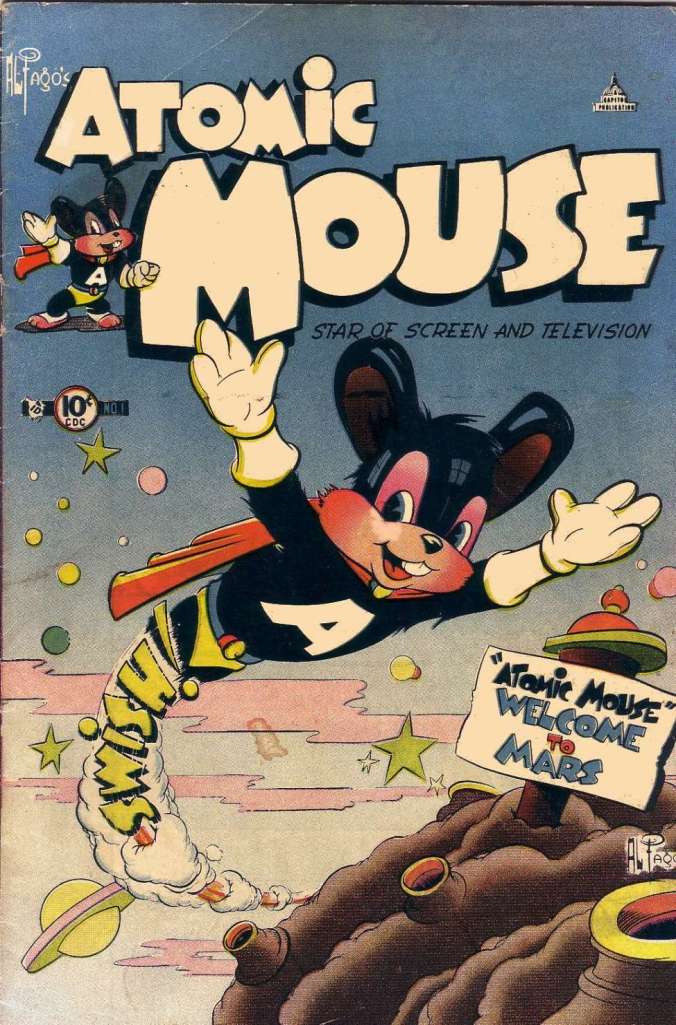
James Flora was a graphics genius, my first serious design influence, and later my great friend and collaborator. He was endlessly inventive. I called his drawings “visual jazz”. – Gene Deitch
Jim Flora in New York – 1970 (Photographer: Gene Deitch)
James (Jim) Flora is best-known for his wild jazz and classical album covers for Columbia Records (late 1940s) and RCA Victor (1950s). He authored and illustrated 17 popular children’s books and flourished for decades as a magazine illustrator. Few realize, however, that Flora (1914-1998) was also a prolific fine artist with a devilish sense of humor and a flair for juxtaposing playfulness, absurdity and violence.
Flora’s album covers pulsed with angular hepcats bearing funnel-tapered noses and shark-fin chins who fingered cockeyed pianos and honked lollipop-hued horns. Yet this childlike exuberance was subverted by a tinge of the diabolic. Flora wreaked havoc with the laws of physics, conjuring flying musicians, levitating instruments, and wobbly dimensional perspectives.
Flora’s TriclopsTaking liberties with human anatomy, he drew bonded bodies and misshapen heads, while inking ghoulish skin tints and grafting mutant appendages. He was not averse to pigmenting jazz legends Benny Goodman and Gene Krupa like bedspread patterns. On some Flora figures, three legs and five arms were standard equipment, with spare eyeballs optional. His rarely seen fine artworks reflect the same comic yet disturbing qualities. “He was a monster,” said artist and Floraphile JD King. So were many of his creations.
JimFlora.com
Below are a few examples of Flora’s works. A number of them are highly valued by jazz fans, art lovers, and album cover collectors. Some of the illustrations may seem familiar to a lot of people yet the name of the artist is unknown to them. Hopefully, Jim Flora’s name will be remembered for future conversation and reference.

Gene Krupa and His Orchestra – Columbia Records, 1947

Louis Armstrong’s Hot 5 – Columbia Records, 1947

Jimmy Dorsey and his Original ‘Dorseyland’ Jazz Band – A Rare 10″ LP, Columbia Records, 1949

Inside Sauter-Finegan – RCA Victor, 1954
One of the best-known album cover illustrations by Jim Flora. Released on RCA Victor in 1954, the record featured the orchestral adventurism of composer-arrangers Eddie Sauter and Bill Finegan. While the figures on the cover in no way resemble the two musicians, Flora’s playful caricatures reflect S-F’s modernist, mid-century approach to redefining big band jazz after the decline of the swing era.
JimFlora.com

Music Of The Bonampak Mexican Ballet and Brazilian Songs – RCA Victor, 1954
Performed by the National Symphony Orchestra of Mexico with Luis Sandi as conductor. The cover features depictions of Mayan characters and cultural images as envisioned by Flora. This album belongs in the classical, world, or folk category.

The War of the Bands Concert (Combined Orchestras of Ralph Flanagan and Buddy Morrow) – RCA Victor, 1954

The Sons of Sauter-Finegan – RCA Victor, 1955
The Sons of Sauter-Finegan was a showcase group formed in 1955 following the success of the collaboration of Bill Finegan and Eddie Sauter in Sauter-Finegan.
![Eugene Ormandy & the Philadelphia Orchestra's Richard Strauss: Till Eulenspiegels [sic] Lustige Streiche and Waltzes from Der Rosenkavalier - Columbia Masterworks 10" LP, 1954](https://atomicscout.files.wordpress.com/2014/04/illustration-from-the-cover-of-eugene-ormandy-the-philadelphia-orchestras-1954-columbia-masterworks.jpg?w=687)
Eugene Ormandy & the Philadelphia Orchestra’s Richard Strauss: Till Eulenspiegels [sic] Lustige Streiche and Waltzes from Der Rosenkavalier – Columbia Masterworks 10″ LP, 1954
This way cool illustration is a work-for-hire piece Flora produced for Columbia Records.
The original artwork no longer exists except on the somewhat rare (and hence very collectible) cardboard sleeve. The bland, generic typesetting is poorly juxtaposed atop Flora’s iconic fine-art imagery. We can only speculate that Flora — who also specialized in mischievous typography — provided the artwork but did not design the package.
Florablog

Strauss: Till Eulenspiegel/Death and Transfiguration – RCA Victor (Red Seal), 1955 (NBC Symphony Orchestra, Arturo Toscanini, conductor)
Flora’s whimsical illustration wonderfully captures the German peasant folk hero Till Eulenspiegel, his misadventures, and pranks chronicled in Strauss’ tone poem.

Mambo for Cats – RCA Victor, 1955
This is a personal favorite – it’s one of Flora’s most renowned and hard-to-find works.
Lastly, here are a few contemporary musical releases that continue the Jim Flora illustration tradition. It’s good to know that Flora’s spirit continues on even after his too soon departure.

Alone With You – Cracked Latin (CD, 2011)
This Cracked Latin CD cover features an adapted design of Flora’s 1970 uncirculated tempera painting entitled, Chance Encounter.

Whirled Chamber Music- Quartet San Francisco (CD, 2007)
This Quartet San Francisco CD cover features an adapted design of Flora’s mid-1960s uncirculated painting entitled, Barberinni.

Terry Adams & the Whole Wheat Horns – Euclid Records 7″, 2009
This 45 rpm single’s sleeve features a Jim Flora musician montage. The chaotic combo, which incorporates cartoonish players from numerous Flora 1940s and 1950s sources, was created by Barbara Economon and Irwin Chusid for their second book, The Curiously Sinister Art of Jim Flora. Both Economon and Chusid maintain the Florablog as well as JimFlora.com.
Visit JimFlora.com for galleries of works, news, fine art prints, articles, links, and history. If you’re interested in purchasing high quality Flora related goods, The Little Shop of Flora’s is open for business.


















![Eugene Ormandy & the Philadelphia Orchestra's Richard Strauss: Till Eulenspiegels [sic] Lustige Streiche and Waltzes from Der Rosenkavalier - Columbia Masterworks 10" LP, 1954](https://atomicscout.files.wordpress.com/2014/04/illustration-from-the-cover-of-eugene-ormandy-the-philadelphia-orchestras-1954-columbia-masterworks.jpg?w=687)






